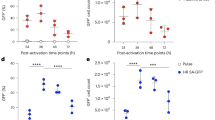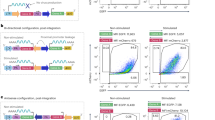Abstract
Retroviral transfer of Herpes simplex virus thymidine kinase to T cells has been used to confer sensitivity to the antiviral agent ganciclovir. This has allowed therapeutic approaches to be developed in which T cells mediating graft-versus-host disease after bone marrow transplantation can be selectively eliminated by the administration of ganciclovir. Although the strategy has been shown to be generally successful in early clinical trials, there are concerns about possible resistance to ganciclovir and the risk of myelosuppressive side-effects at the doses required to induce T cell suicide. We have incorporated the enhanced mutant HSV-TKSR39 into retroviral vectors tailored to exhibit high levels of expression in T cells and have used protocols optimized for the transduction and selection of primary lymphocytes. We demonstrate that leukemic and primary T cells can be efficiently transduced and highly enriched under conditions that should be readily adaptable for clinical use. T cells carrying HSV-TKSR39 were inhibited by exposure to ganciclovir at concentrations an order of magnitude below those required for wild-type HSV-TK. The less toxic agent aciclovir also eliminated T cells transduced with HSV-TKSR39 (but not HSV-TK), underlining the increased therapeutic potential of the mutant suicide gene system in the bone marrow transplantation setting.
This is a preview of subscription content, access via your institution
Access options
Subscribe to this journal
Receive 12 print issues and online access
$259.00 per year
only $21.58 per issue
Buy this article
- Purchase on Springer Link
- Instant access to full article PDF
Prices may be subject to local taxes which are calculated during checkout




Similar content being viewed by others
References
Socie G, Cahn J . Acute graft-versus-host disease Barrett J, Treleaven J (eds); The Clinical Practice of Stem Cell Transplantation ISIS Medical Media 1998 pp 596–618
Vogelsang GB . How I treat chronic graft-versus-host disease Blood 2001 97: 1196–1201
Klingebiel T, Schlegel PG . GVHD: overview on pathophysiology, incidence, clinical and biological features Bone Marrow Transplant 1998 21: S45–S49
Kolb HJ et al. Graft-versus-leukemia effect of donor lymphocyte transfusions in marrow grafted patients. European Group for Blood and Marrow Transplantation Working Party Chronic Leukemia Blood 1995 86: 2041–2050
Marmont AM et al. T-cell depletion of HLA-identical transplants in leukemia Blood 1991 78: 2120–2130
Gee A, Lee C . T cell depletion of allogeneic stem cell grafts Barrett J, Treleaven J (eds); The Clinical Practice of Stem Cell Transplantation ISIS Medical Media 1998 pp 474–505
Bonini C et al. HSV-TK gene transfer into donor lymphocytes for control of allogeneic graft-versus-leukemia Science 1997 276: 1719–1724
Tiberghien P et al. Administration of herpes simplex-thymidine kinase-expressing donor T cells with a T-cell-depleted allogeneic marrow graft Blood 2001 97: 63–72
Greco O, Dachs GU . Gene directed enzyme/prodrug therapy of cancer: historical appraisal and future prospectives J Cell Physiol 2001 187: 22–36
Verzeletti S et al. Herpes simplex virus thymidine kinase gene transfer for controlled graft-versus-host disease and graft-versus-leukemia: clinical follow-up and improved new vectors Hum Gene Ther 1998 9: 2243–2251
Verzeletti S et al. Herpes simplex virus thymidine kinase gene transfer for controlled graft-versus-host disease and graft-versus-leukemia: clinical follow-up and improved new vectors Bonini C et al. Infusion of donor lymphocytes expressing a suicide gene for controlled immune reconstitution and anti-tumour reactivity after stem cell transplantation. Am Soc Gene Ther 2001; Abstr. S114
Baum C et al. Novel retroviral vectors for efficient expression of the multidrug resistance (mdr-1) gene in early hematopoietic cells J Virol 1995 69: 7541–7547
Gallardo HF, Tan C, Sadelain M . The internal ribosomal entry site of the encephalomyocarditis virus enables reliable coexpression of two transgenes in human primary T lymphocytes Gene Therapy 1997 4: 1115–1119
Yang TT, Cheng L, Kain SR . Optimized codon usage and chromophore mutations provide enhanced sensitivity with the green fluorescent protein Nucleic Acids Res 1996 24: 4592–4593
Mavilio F et al. Peripheral blood lymphocytes as target cells of retroviral vector-mediated gene transfer Blood 1994 83: 1988–1997
Black ME, Kokoris MS, Sabo P . Herpes simplex virus-1 thymidine kinase mutants created by semi-random sequence mutagenesis improve prodrug-mediated tumor cell killing Cancer Res 2001 61: 3022–3026
Hanenberg H et al. Colocalization of retrovirus and target cells on specific fibronectin fragments increases genetic transduction of mammalian cells Nat Med 1996 2: 876–882
Miller AD et al. Construction and properties of retrovirus packaging cells based on gibbon ape leukemia virus J Virol 1991 65: 2220–2224
Cosset FL et al. High-titer packaging cells producing recombinant retroviruses resistant to human serum J Virol 1995 69: 7430–7436
Kokoris MS, Sabo P, Adman ET, Black ME . Enhancement of tumor ablation by a selected HSV-1 thymidine kinase mutant Gene Therapy 1999 6: 1415–1426
Garin MI et al. Molecular mechanism for ganciclovir resistance in human T lymphocytes transduced with retroviral vectors carrying the herpes simplex virus thymidine kinase gene Blood 2001 97: 122–129
Qiao J, Black ME, Caruso M . Enhanced ganciclovir killing and bystander effect of human tumor cells transduced with a retroviral vector carrying a herpes simplex virus thymidine kinase gene mutant Hum Gene Ther 2000 11: 1569–1576
Black ME, Newcomb TG, Wilson HM, Loeb LA . Creation of drug-specific herpes simplex virus type 1 thymidine kinase mutants for gene therapy Proc Natl Acad Sci USA 1996 93: 3525–3529
Acknowledgements
WQ is supported by Action Research and AT by the Wellcome Trust. The project is also supported by the Lee Smith Research Fund.
Author information
Authors and Affiliations
Rights and permissions
About this article
Cite this article
Qasim, W., Thrasher, A., Buddle, J. et al. T cell transduction and suicide with an enhanced mutant thymidine kinase. Gene Ther 9, 824–827 (2002). https://doi.org/10.1038/sj.gt.3301690
Received:
Accepted:
Published:
Issue Date:
DOI: https://doi.org/10.1038/sj.gt.3301690
Keywords
This article is cited by
-
Chimeric Antigen Receptor–Modified T Cells and T Cell–Engaging Bispecific Antibodies: Different Tools for the Same Job
Current Hematologic Malignancy Reports (2021)
-
Teaching an old dog new tricks: next-generation CAR T cells
British Journal of Cancer (2019)
-
Thymidine Kinase Suicide Gene-mediated Ganciclovir Ablation of Autologous Gene-modified Rhesus Hematopoiesis
Molecular Therapy (2012)
-
Engineered Human tmpk/AZT As a Novel Enzyme/Prodrug Axis for Suicide Gene Therapy
Molecular Therapy (2007)
-
Effective Suicide Gene Therapy for Leukemia in a Model of Insertional Oncogenesis in Mice
Molecular Therapy (2007)



